CD161(int)CD8+ T cells: a novel population of highly functional, memory CD8+ T cells enriched within the gut
- PMID: 26220166
- PMCID: PMC4732939
- DOI: 10.1038/mi.2015.69
CD161(int)CD8+ T cells: a novel population of highly functional, memory CD8+ T cells enriched within the gut
Abstract
The C-type lectin-like receptor CD161 is expressed by lymphocytes found in human gut and liver, as well as blood, especially natural killer (NK) cells, T helper 17 (Th17) cells, and a population of unconventional T cells known as mucosal-associated invariant T (MAIT) cells. The association of high CD161 expression with innate T-cell populations including MAIT cells is established. Here we show that CD161 is also expressed, at intermediate levels, on a prominent subset of polyclonal CD8+ T cells, including antiviral populations that display a memory phenotype. These memory CD161(int)CD8+ T cells are enriched within the colon and express both CD103 and CD69, markers associated with tissue residence. Furthermore, this population was characterized by enhanced polyfunctionality, increased levels of cytotoxic mediators, and high expression of the transcription factors T-bet and eomesodermin (EOMES). Such populations were induced by novel vaccine strategies based on adenoviral vectors, currently in trial against hepatitis C virus. Thus, intermediate CD161 expression marks potent polyclonal, polyfunctional tissue-homing CD8+ T-cell populations in humans. As induction of such responses represents a major aim of T-cell prophylactic and therapeutic vaccines in viral disease and cancer, analysis of these populations could be of value in the future.
Conflict of interest statement
Disclosure: The authors declare no conflict of interest.
Figures
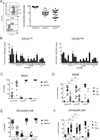
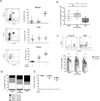
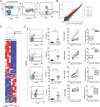
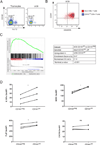

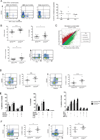

Similar articles
-
Enhanced Th1/Th17 Functions of CD161+ CD8+ T Cells in Mucosal Tissues of Rhesus Macaques.PLoS One. 2016 Jun 16;11(6):e0157407. doi: 10.1371/journal.pone.0157407. eCollection 2016. PLoS One. 2016. PMID: 27309719 Free PMC article.
-
Functional Heterogeneity and Antimycobacterial Effects of Mouse Mucosal-Associated Invariant T Cells Specific for Riboflavin Metabolites.J Immunol. 2015 Jul 15;195(2):587-601. doi: 10.4049/jimmunol.1402545. Epub 2015 Jun 10. J Immunol. 2015. PMID: 26063000 Free PMC article.
-
CD161 Defines a Functionally Distinct Subset of Pro-Inflammatory Natural Killer Cells.Front Immunol. 2018 Apr 9;9:486. doi: 10.3389/fimmu.2018.00486. eCollection 2018. Front Immunol. 2018. PMID: 29686665 Free PMC article.
-
CD8+CD161+ T-Cells: Cytotoxic Memory Cells With High Therapeutic Potential.Front Immunol. 2021 Feb 1;11:613204. doi: 10.3389/fimmu.2020.613204. eCollection 2020. Front Immunol. 2021. PMID: 33597948 Free PMC article. Review.
-
New Insights on CD8+ T Cells in Inflammatory Bowel Disease and Therapeutic Approaches.Front Immunol. 2021 Oct 11;12:738762. doi: 10.3389/fimmu.2021.738762. eCollection 2021. Front Immunol. 2021. PMID: 34707610 Free PMC article. Review.
Cited by
-
CXCL16 Stimulates Antigen-Induced MAIT Cell Accumulation but Trafficking During Lung Infection Is CXCR6-Independent.Front Immunol. 2020 Aug 7;11:1773. doi: 10.3389/fimmu.2020.01773. eCollection 2020. Front Immunol. 2020. PMID: 32849637 Free PMC article.
-
A subset of cytotoxic effector memory T cells enhances CAR T cell efficacy in a model of pancreatic ductal adenocarcinoma.Sci Transl Med. 2021 May 5;13(592):eabc3196. doi: 10.1126/scitranslmed.abc3196. Sci Transl Med. 2021. PMID: 33952672 Free PMC article.
-
Immune Regulation and Antitumor Effect of TIM-1.J Immunol Res. 2016;2016:8605134. doi: 10.1155/2016/8605134. Epub 2016 Jun 20. J Immunol Res. 2016. PMID: 27413764 Free PMC article. Review.
-
Inhibitory CD161 receptor identified in glioma-infiltrating T cells by single-cell analysis.Cell. 2021 Mar 4;184(5):1281-1298.e26. doi: 10.1016/j.cell.2021.01.022. Epub 2021 Feb 15. Cell. 2021. PMID: 33592174 Free PMC article.
-
Chronic hepatitis C viral infection subverts vaccine-induced T-cell immunity in humans.Hepatology. 2016 May;63(5):1455-70. doi: 10.1002/hep.28294. Epub 2016 Jan 22. Hepatology. 2016. PMID: 26474390 Free PMC article.
References
-
- Gebhardt T, et al. Memory T cells in nonlymphoid tissue that provide enhanced local immunity during infection with herpes simplex virus. Nat. Immunol. 2009;10:524–530. - PubMed
-
- Masopust D, Vezys V, Wherry EJ, Barber DL, Ahmed R. Cutting Edge: Gut Microenvironment Promotes Differentiation of a Unique Memory CD8 T Cell Population. J. Immunol. 2006;176:2079–2083. - PubMed
-
- Lanier LL, Chang C, Phillips JH. Human NKRP1A. A disulfide-linked homodimer of the C-type lectin superfamily expressed by a subset of NK and T lymphocytes. J. Immunol. 1994;153:2417–2428. - PubMed
Publication types
MeSH terms
Substances
Grants and funding
LinkOut - more resources
Full Text Sources
Other Literature Sources
Medical
Research Materials

